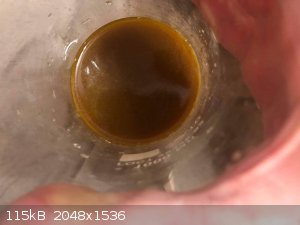vano
National Hazard
   
Posts: 661
Registered: 22-3-2019
Location: Georgia
Member Is Offline
|
|
Copper dibromodiiodocadmate
We know Potassium Tetracyanocadmate exists. But i want to try Copper dibromodiiodocadmate.The reactions are as follows. Do you think it will work?
2KI + CdBr2 = K2[CdBr2I2]
K2[CdBr2I2] + CuSO4 = Cu[CdBr2I2] + K2SO4
|
|
|
vano
National Hazard
   
Posts: 661
Registered: 22-3-2019
Location: Georgia
Member Is Offline
|
|
At the end of the reaction the solution had such a color.

|
|
|
DraconicAcid
International Hazard
    
Posts: 4278
Registered: 1-2-2013
Location: The tiniest college campus ever....
Member Is Offline
Mood: Semi-victorious.
|
|
I suspect you will also get some formation of iodine and CuI.
Please remember: "Filtrate" is not a verb.
Write up your lab reports the way your instructor wants them, not the way your ex-instructor wants them.
|
|
|
vano
National Hazard
   
Posts: 661
Registered: 22-3-2019
Location: Georgia
Member Is Offline
|
|
I thought so too, but I will find out exactly tomorrow when I dry.
|
|
|
DraconicAcid
International Hazard
    
Posts: 4278
Registered: 1-2-2013
Location: The tiniest college campus ever....
Member Is Offline
Mood: Semi-victorious.
|
|
There's really no comparison between potassium tetracyanocadmate and copper dibromodiiodocadmate. First, cyanide is a much better ligand to a
transition metal than a halide ion. Secondly, the halide ions are just as likely to coordinate to copper as they are to cadmium (unlike potassium,
which just doesn't do simple coordination chemistry, unless you count crown ethers in organic solvents).
It's well-known that [Hg(SCN)4](2-) forms precipitates with metals such as copper and zinc, but I suspect the structure isn't as simple as the formula
suggests.
Please remember: "Filtrate" is not a verb.
Write up your lab reports the way your instructor wants them, not the way your ex-instructor wants them.
|
|
|
vano
National Hazard
   
Posts: 661
Registered: 22-3-2019
Location: Georgia
Member Is Offline
|
|
Yes I agree with you. It is true that the halide ion acts likely on cadmium and copper. However, in addition to thiocyanate, copper also produces
tetraiodomercurate, when the solution contains mercury ions, a red compound is formed upon mixing the solution. I also tried to make
dibromodiiodomercurate and it also precipitated instantly, if the compound precipitated instantly after the exchange reaction then it does not matter
that the halide ion acts the same if potassium salt is not in excess. But the case of cadmium is different from that of mercury, but it was worth a
try.
|
|
|
woelen
Super Administrator
        
Posts: 7977
Registered: 20-8-2005
Location: Netherlands
Member Is Offline
Mood: interested
|
|
I think that the combination of copper(II) and iodide is not a stable one. Copper(II) oxidizes iodide to iodine, at least partially. Probably that is
the cause of the brown color.
What would be interesting is to see whether you can make a copper(I) complex of cadmium, maybe Cu2[CdBr4]?
|
|
|
vano
National Hazard
   
Posts: 661
Registered: 22-3-2019
Location: Georgia
Member Is Offline
|
|
@Woelen I can try tomorrow. I will use potassium bromide instead of iodide.
[Edited on 17-1-2021 by vano]
|
|
|
Bezaleel
Hazard to Others
  
Posts: 444
Registered: 28-2-2009
Member Is Offline
Mood: transitional
|
|
That's true, but it
does not seem that it excreted any iodine. When I added KI to CuSO4 solution, the iodine just floated on top of the solution. In vano's photo, it
stayed in suspension, at least.
|
|
|
vano
National Hazard
   
Posts: 661
Registered: 22-3-2019
Location: Georgia
Member Is Offline
|
|
Bezaleel you are right. The reaction between copper and potassium iodide is different.
|
|
|
woelen
Super Administrator
        
Posts: 7977
Registered: 20-8-2005
Location: Netherlands
Member Is Offline
Mood: interested
|
|
Depends on how much KI you add to CuSO4. If you add excess KI, then no solid iodine will be visible, all of it will remain in solution as brown I3(-)
ion. I do not know the precise conditions of vano's experiment, but I can imagine that some iodine is formed, which remains dissolved and that the
resulting copper(I) forms an insoluble solid with some cadmium-complex. This could explain the combination of brown color and the solution not being
clear.
|
|
|
vano
National Hazard
   
Posts: 661
Registered: 22-3-2019
Location: Georgia
Member Is Offline
|
|
@woelen it does not work. But I think a K2[CdBr4] complex formed in the solution, Because when I added the copper sulfate solution, the solution did
not change color, it was just blue. That is, there were no free bromine anions in the solution.
|
|
|
Bedlasky
International Hazard
    
Posts: 1219
Registered: 15-4-2019
Location: Period 5, group 6
Member Is Offline
Mood: Volatile
|
|
Vano: But Woelen spoke about Cu2[CdBr4], not about Cu[CdBr4]. You need firstly reduce copper with metabisulfite, than add this solution in to
[CdBr4]2- solution. Mercury form analogous red precipitate.
|
|
|
vano
National Hazard
   
Posts: 661
Registered: 22-3-2019
Location: Georgia
Member Is Offline
|
|
Oh, I thought he was talking about divalent copper. I will try with copper monochloride. Wait a minute.
|
|
|
vano
National Hazard
   
Posts: 661
Registered: 22-3-2019
Location: Georgia
Member Is Offline
|
|
I did it twice. First in a test tube, then in a flask, but nothing happened. If you have other ideas I can try it too. I also made Cu2[HgI2Br2] .
[Edited on 18-1-2021 by vano]
|
|
|